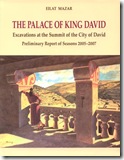I was traveling last week when the Jerusalem Post reported on the installation of a model of the Second Temple above the Western Wall plaza, but readers who didn’t see it elsewhere may be interested. You can see another photo of the model at Arutz-7; it looks very similar to the model at the Israel Museum (formerly Holyland Hotel).
Some 50 people gathered on Wednesday to watch the installation of a Second Temple model on the roof of a yet-unfinished Aish HaTorah yeshiva building, across from the Western Wall and just a few hundred meters from where the real thing once stood.
With the Dome of the Rock and the Aksa Mosque standing conspicuously in the background, a crane lowered the 1.2-ton model onto the roof.
It took about a year for Michael Osanis, an immigrant from the former Soviet Union who has built a number of other Temple models, including one in the Temple Institute, also in the capital’s Jewish Quarter, to complete this model, which is made from gold, silver, wood and Jerusalem stone.
The model will sit on a new educational building for Aish HaTorah’s short-term outreach programs, which is set to open in December.
Aish, which provides a network of educational programs for Jews around the world, is also building a new “Exploratorium” – an interactive museum on Jewish history, which it expects will host 300,000 visitors annually after it opens in two years.
“What could be more appropriate than to have here, as people are standing looking out over our holiest place, the Temple Mount, a sense of what it was really like to have the Temple here?” asked Ephraim Shore, director of Aish’s programs in Jerusalem.
The yeshiva hopes that this model will help people to visualize the Temple and therefore forge a stronger connection with Judaism and Jewish history.
“It is hard for us to imagine a Temple and to feel that we are praying inside the Temple,” said Rabbi Hillel Weinberg, the head of Aish’s Jerusalem yeshiva.
“But now, everyone who comes and sees this Temple model, it will be much easier for them to connect to the Temple and to direct their prayers to the Holy of Holies.”
As the crane lowered the model into place, an argument broke out about which direction it should face. Should it mirror the way the actual Temple sat in relation to the Temple Mount, or sit the opposite way, making it easier for large crowds to see it?
Osanis swiftly decided that ease of access was more important, and positioned the model accordingly. Not everyone in the crowd was happy with the decision.
The story continues here.
HT: Joe Lauer
